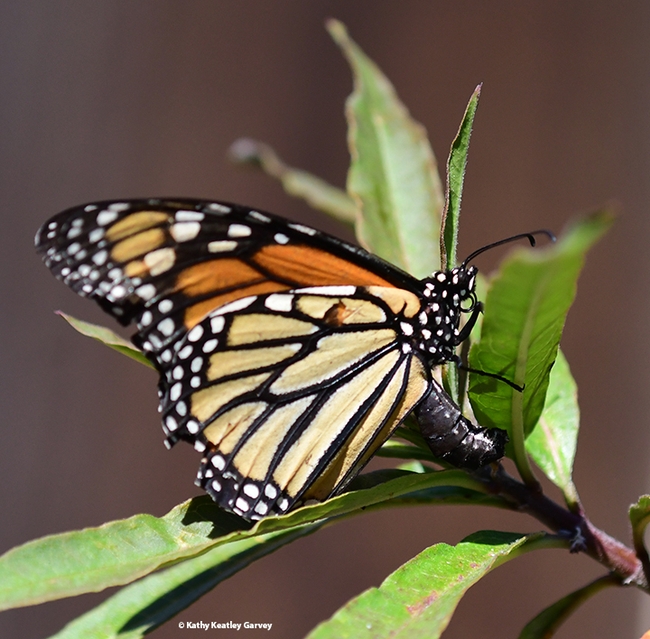She came, she saw, she oviposited, she nectared and she left.
That's the extent of our sole monarch sighting in our Vacaville pollinator garden this year. This occurred Oct. 9.
But the good news is that more monarchs are gathering on the overwintering sites along the California coast than this time last year. And this is occurring during a major drought year.
In an article, Monarch Butterflies Return to Pacific Grove. And the Drought May Be the Reason for Their Rebound, published yesterday (Oct. 21) in the San Francisco Chronicle, Tara Duggan wrote:
"For once there is some promising news for western monarch butterflies: Around 2,600 of the migratory insects were counted at Pacific Grove Thursday, after zero were observed at the famed Monterey County sanctuary last year. And overall, conservationists estimate the current population that has arrived in its annual wintertime migration to the California coast to be around 10,000 compared to 1,900 last year.
"One possible reason for the rebound: this year's drought, since warm and dry conditions in early spring can help with their migration."
Many others haves noticed the uptick, too. On Oct. 14, entomologist David James of Washington State University wrote on his Monarchs Butterflies of the Pacific Coast Facebook page: "Another exciting and encouraging update on monarch arrivals at the California overwintering sites. Combining all the reports I've received over the past few days there are an estimated 1500 butterflies at 5 overwintering sites from Santa Cruz to Pismo Beach. And still the butterflies are arriving... The highest number at one site is about 700 at a site in the Pismo beach area. This exceeds the highest number seen at one site in 2020 (550 at Natural Bridges). Pacific Grove is reported to have about 200 butterflies. This is especially notable since none were recorded at this site in 2020. Inbound migration will continue for a few more weeks yet but even at this early stage we are close to exceeding the entire population counted at overwintering sites in 2020. Good news, indeed!"
Volunteers counted only 1900 on the overwintering sites along the California coast in 2020, according to the Xerces Society for Invertebrate Conservation. Compare that to approximately 29,000 in 2019 and almost 200,000 in 2017.
"But on Wednesday (Oct. 20) volunteers counted 8,000 of the butterflies at two groves in Pismo Beach, compared to 300 last year," wrote Duggan.
Scientists, including Art Shapiro, UC Davis distinguished professor of evolution and ecology, say the main reasons for the decline of the monarchs are habitat loss and pesticides.
Plant milkweed, plant nectar sources and lose the pesticides.
(Editor's Note: Due to UC ANR server issues, images aren't visible. Click on the icon to see the image)
Attached Images:
